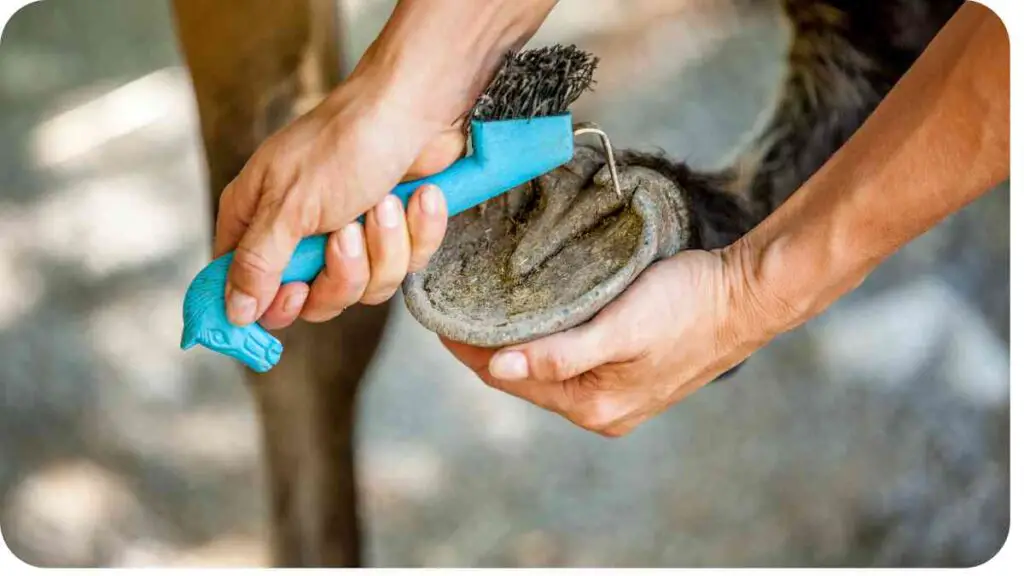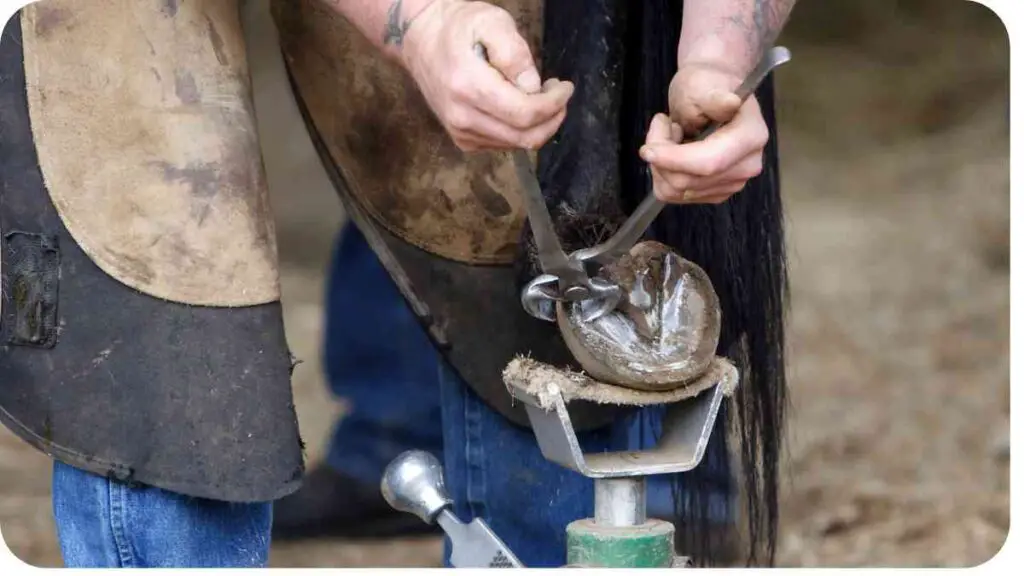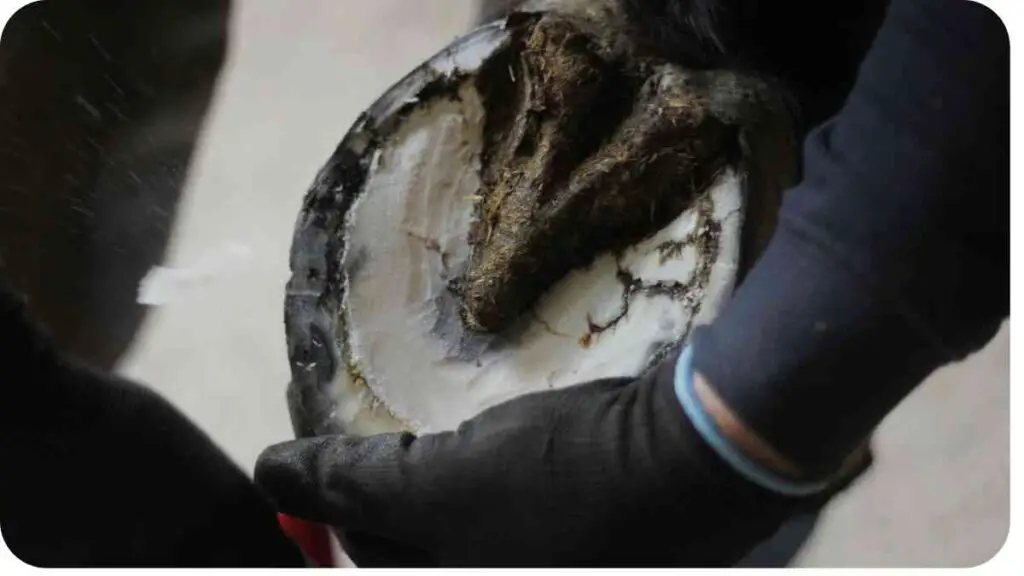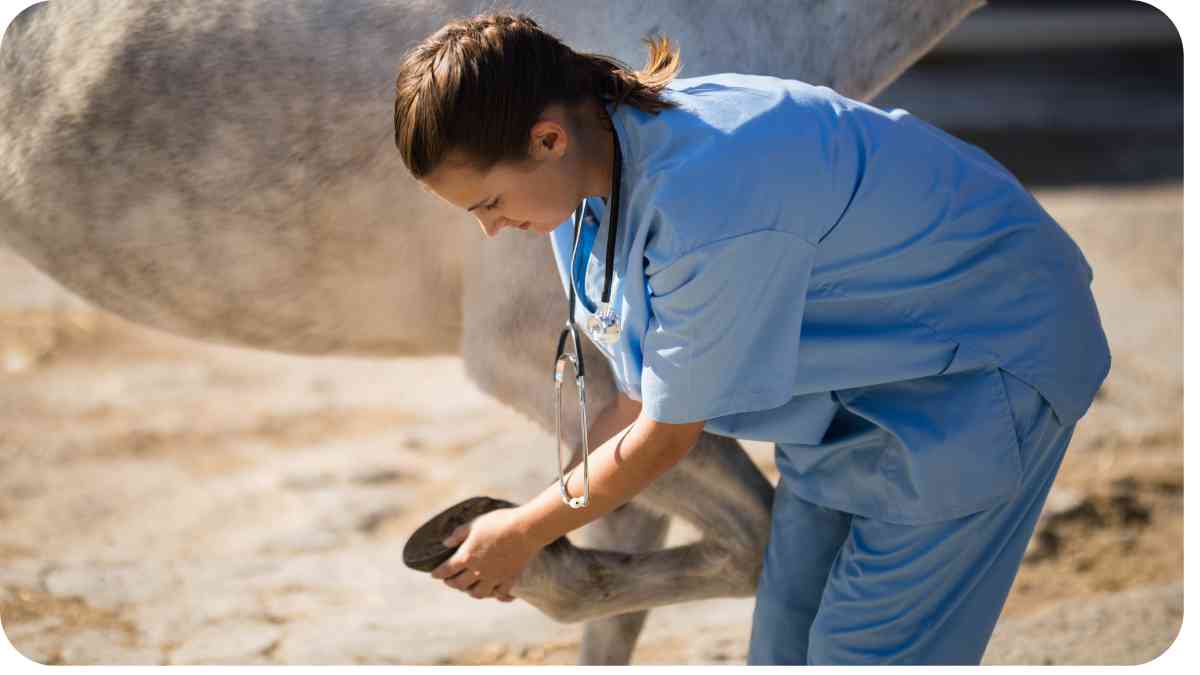As a horse owner or enthusiast, you’ve likely pondered the question: do horses enjoy being fitted for shoes? This article delves into the nuanced world of equine comfort and explores the perceptions and experiences of our four-legged friends during the shoe-fitting process.
| Takeaways |
|---|
| 1. Proper Hoof Care is Vital: Investing in good hoof care is essential for a horse’s overall well-being, impacting balance, posture, and performance. |
| 2. Understanding Equine Sensitivity: Horses are highly sensitive creatures, especially in their hooves. This sensitivity influences their perception of the shoe-fitting process. |
| 3. Building Trust is Key: Establishing trust between the horse and the handler is fundamental for a positive shoe-fitting experience. |
| 4. Signs of Discomfort: Being attuned to behavioral and physical signs helps identify whether a horse is comfortable during shoe fittings. |
| 5. The Art of Gentle Fitting: Choosing the right farrier, using proper equipment, and introducing the process gradually contribute to a more comfortable experience. |
| 6. Psychological Impact of Shoes: Well-fitted shoes can boost a horse’s confidence and positively influence their performance. |
| 7. Exploring Alternatives: Consider alternative methods such as the barefoot hoof movement and innovative protection approaches. |
| 8. Real-world Success Stories: Case studies highlight the positive impact of proper hoof care, showcasing rehabilitation and improved performance. |
| 9. Tips for Horse Owners: Regular hoof maintenance, clear communication with the farrier, and understanding horse signals contribute to a positive experience. |
| 10. Additional Resources: Further reading and a glossary of terms provide additional insights and information for horse owners and enthusiasts. |
2. The Importance of Proper Hoof Care

Proper hoof care is vital for a horse’s overall well-being. Well-maintained hooves contribute to a horse’s balance, posture, and even their performance. In this section, we’ll discuss why investing in good hoof care is an essential aspect of responsible horse ownership.
Maintaining optimal hoof health is crucial for every horse owner. Explore hoof care practices to ensure your horse’s comfort, mobility, and overall well-being
3. How Horses Perceive Shoe Fittings
Understanding how horses perceive the process of being fitted for shoes is crucial. We’ll explore their sensitivity, the role of trust in the equation, and the factors that contribute to a positive experience for the horse.
3.1 Understanding Equine Sensitivity
Horses are remarkably sensitive creatures. Their hooves, in particular, are packed with nerve endings, making them highly receptive to touch and pressure. How does this sensitivity play a role in their perception of the shoe-fitting process?
3.2 The Role of Trust in the Process
Trust is the foundation of any positive interaction between humans and horses. We’ll delve into how establishing trust with your horse can significantly impact their comfort and cooperation during the fitting process.
“Discover the benefits of using rubber shoes as protective alternatives for your horse’s hooves. Learn how these options can contribute to comfort and long-term hoof health
4. Signs of Discomfort During Shoe Fittings
It’s essential for horse owners and farriers to be attuned to signs of discomfort during shoe fittings. We’ll outline both behavioral indicators and physical signs that may suggest the horse is not enjoying the process.
4.1 Behavioral Indicators
Horses communicate through body language. We’ll discuss subtle cues that may indicate stress, fear, or discomfort during the fitting, allowing owners and farriers to respond appropriately.
4.2 Physical Signs
Beyond behavior, horses may exhibit physical signs of discomfort. This section will provide insights into how changes in posture, movement, or even vocalizations can signify a lack of enjoyment during shoe fittings.
Uncover the truth about horse shoeing and its impact on hoof health. Ensure your horse’s well-being by understanding the considerations and practices involved in this essential aspect of equine care.
5. The Art of Gentle Shoe Fitting

Ensuring a positive experience for horses during shoe fittings involves adopting a gentle approach. We’ll explore the importance of choosing the right farrier, using proper equipment, and gradually introducing the process to minimize stress.
5.1 Choosing the Right Farrier
The farrier’s expertise and demeanor play a pivotal role in the horse’s experience. We’ll discuss the qualities to look for in a farrier to ensure a positive and comfortable shoe-fitting session.
5.2 Using Proper Equipment
The tools and equipment used during shoe fittings can impact the horse’s comfort. We’ll highlight key considerations in selecting and using the right equipment for a gentle and effective fitting.
5.3 Gradual Introduction to the Process
Introducing the horse to the shoe-fitting process gradually can make a significant difference. We’ll explore strategies for acclimating horses to the various sensations and procedures involved.
Explore why donkeys often don’t require shoes and understand their durable hooves. Gain insights into the natural resilience of donkey hooves, shedding light on the considerations for hoof care in different equine species.
6. Personal Experiences and Insights
Drawing from personal experiences in the field, this section shares insights into navigating resistance during shoe fittings and building positive associations with the process.
6.1 Navigating Resistance
Every horse is unique, and some may resist the shoe-fitting process. We’ll share anecdotes and practical tips on how to navigate resistance, fostering cooperation and reducing stress for both horse and handler.
6.2 Building Positive Associations
Creating positive associations with shoe fittings is key to ensuring a horse’s enjoyment. We’ll discuss methods for associating the process with positive experiences, making it a more comfortable and stress-free endeavor.
Timing is crucial when deciding to add horseshoes. Learn when it’s appropriate to enhance your horse’s hoof protection. Explore the signs indicating the need for horseshoes and ensure your horse’s comfort during various activities.
7. Expert Opinions on Equine Comfort

In this section, we’ll gather perspectives from farriers and veterinarians, shedding light on their experiences and insights into ensuring equine comfort during shoe fittings.
7.1 Farriers’ Perspectives
Experienced farriers offer valuable insights into understanding horses’ reactions during shoe fittings and share tips on creating a positive and enjoyable experience.
7.2 Veterinarians’ Insights
Veterinarians contribute their expertise by providing insights into the physiological aspects of horse comfort during shoe fittings. Their perspectives help bridge the gap between equine health and the fitting process.
8. Common Misconceptions About Horseshoes
Dispelling common myths surrounding horseshoes is essential for a well-informed perspective on equine comfort. We’ll address misconceptions about horseshoes being restrictive and painful applications.
8.1 Horseshoes as a Restriction
Contrary to popular belief, horseshoes, when fitted correctly, provide support without restricting natural movement. We’ll explore how a well-fitted horseshoe can enhance rather than hinder a horse’s mobility.
8.2 Debunking the Myth of Painful Applications
Understanding the proper application of horseshoes is crucial. We’ll debunk myths surrounding painful applications, emphasizing the importance of skilled farriers and suitable techniques.
9. The Psychological Impact of Shoes on Horses
Delving into the psychological aspects, we’ll explore how shoes can impact a horse’s confidence, performance, and the delicate balance between comfort and necessity.
9.1 Confidence and Performance
Well-fitted shoes can boost a horse’s confidence and positively influence their performance. We’ll discuss how the psychological impact of shoes goes beyond physical comfort.
9.2 Balancing Act: Comfort vs. Necessity
Finding the right balance between providing comfort and recognizing the necessity of shoe fittings is essential. We’ll provide insights into making informed decisions that prioritize the horse’s overall well-being.
10. Alternatives to Traditional Horseshoes
Exploring alternative methods for hoof protection, this section discusses the barefoot hoof movement and innovative approaches beyond traditional horseshoes.
10.1 Barefoot Hoof Movement
The barefoot hoof movement advocates for a more natural approach to hoof care. We’ll delve into the principles behind barefoot hoof care and its potential benefits for horses.
10.2 Innovative Hoof Protection Methods
Beyond traditional horseshoes, innovative hoof protection methods are emerging. We’ll discuss the latest technologies and techniques that aim to provide effective protection while ensuring the horse’s comfort.
11. Case Studies: Success Stories in Hoof Care
Real-world examples are powerful in illustrating the positive impact of proper hoof care. This section presents case studies, including rehabilitation stories and narratives of improved performance due to effective shoe fittings.
11.1 Rehabilitation Stories
Horses facing hoof-related challenges can undergo remarkable transformations with proper care. We’ll share stories of rehabilitation, highlighting the role of shoe fittings in restoring health and functionality.
11.2 Improved Performance Narratives
Performance horses, whether in sports or work, can benefit significantly from well-fitted shoes. We’ll explore success stories where horses’ performance levels improved after receiving tailored hoof care.
12. Tips for Horse Owners: Ensuring a Positive Experience
Providing practical advice for horse owners, this section offers tips on regular hoof maintenance, communication with the farrier, and recognizing and responding to signals from the horse during the shoe-fitting process.
12.1 Regular Hoof Maintenance
Maintaining healthy hooves between shoe fittings is crucial. We’ll provide actionable tips on how horse owners can contribute to their horse’s overall hoof health through regular maintenance practices.
12.2 Communication with the Farrier
Effective communication with the farrier is key to a positive experience. We’ll discuss how clear communication ensures that the farrier understands the horse’s needs and the owner’s expectations.
12.3 Observing and Responding to Horse Signals
Horses communicate through body language, and keen observation is vital. We’ll share tips on how horse owners can observe and respond to signals during the shoe-fitting process, fostering a more comfortable experience.
13. Conclusion
In conclusion, the question of whether horses enjoy being fitted for shoes is nuanced and depends on various factors. Proper hoof care is undeniably crucial for a horse’s well-being, and the shoe-fitting process plays a significant role in achieving this.
Understanding equine sensitivity, building trust, and being attentive to signs of discomfort are essential aspects of ensuring a positive experience for horses during shoe fittings. The art of gentle shoe fitting involves choosing the right farrier, using proper equipment, and introducing the process gradually to minimize stress.
While dispelling common misconceptions about horseshoes, it’s important to acknowledge the psychological impact of shoes on horses. Well-fitted shoes can enhance confidence and performance, striking a delicate balance between comfort and necessity.
Exploring alternatives to traditional horseshoes, such as the barefoot hoof movement and innovative protection methods, offers horse owners additional options to consider. Case studies highlight the success stories of rehabilitation and improved performance due to effective shoe fittings.
Providing practical tips for horse owners, including regular hoof maintenance, clear communication with the farrier, and understanding and responding to horse signals, ensures a positive experience for both the horse and the handler.
Further Reading
- Why Do Horses Need Shoes? A Comprehensive Horse Shoeing Guide: This detailed guide explores the reasons behind why horses may need shoes, providing valuable insights into the considerations and benefits of horse shoeing.
- Do Horses Like Wearing Shoes? Understanding Equine Preferences: Trisha Wren delves into the topic of horses’ preferences regarding shoe-wearing, offering a nuanced perspective on the comfort and enjoyment factors.
- Are Horseshoes Cruel and Painful? Debunking Myths About Horse Shoeing: This article tackles common misconceptions surrounding horseshoes, addressing the belief that shoeing is inherently cruel or painful for horses.
FAQs
Do horses enjoy wearing shoes?
Horses’ enjoyment of wearing shoes can vary. Factors such as proper fitting, gradual introduction, and individual preferences play a role in determining a horse’s comfort level.
Is barefoot hoof care a suitable alternative to traditional horseshoes?
Barefoot hoof care is considered by some as a natural alternative. However, its suitability depends on various factors, including the horse’s lifestyle, hoof health, and the specific demands placed on their hooves.
How can I tell if my horse is uncomfortable during a shoe fitting?
Observing behavioral indicators and physical signs is crucial. Signs of distress may include resistance, changes in posture, or vocalizations. A skilled farrier can also provide insights.
Are there alternatives to traditional horseshoes?
Yes, there are alternatives, such as the barefoot hoof movement and innovative protection methods. Exploring these options depends on the horse’s needs and the goals of hoof care.
What role does trust play in a positive shoe-fitting experience for horses?
Trust is fundamental. Horses are sensitive animals, and establishing trust with the farrier contributes to a positive experience. A trusting relationship minimizes stress and ensures cooperation during the fitting process.

Hi there! My name is Hellen James, and I’m a horse riding expert. I’ve been riding horses since I was just a kid—and it’s been my passion ever since. But getting started with horse riding can be overwhelming. There’s so much to learn! If you’re looking for a way to get started and make sure you’re doing it right, I’m here to help.


